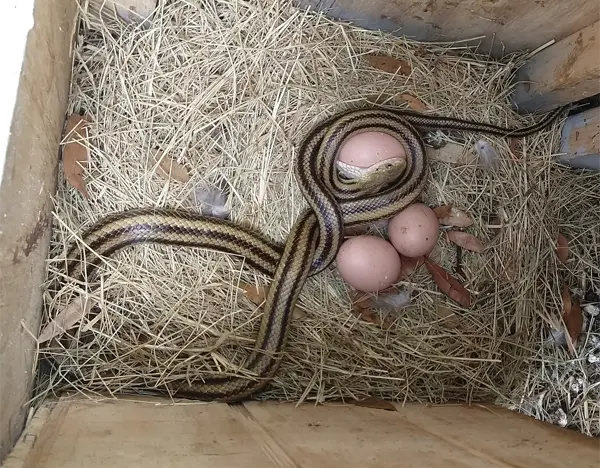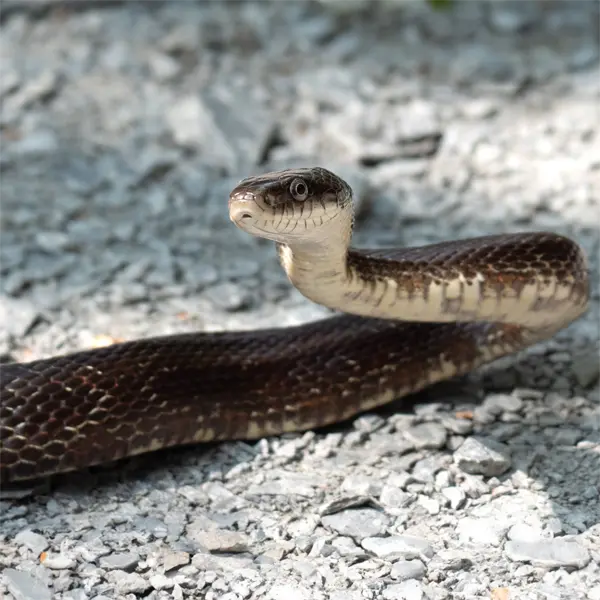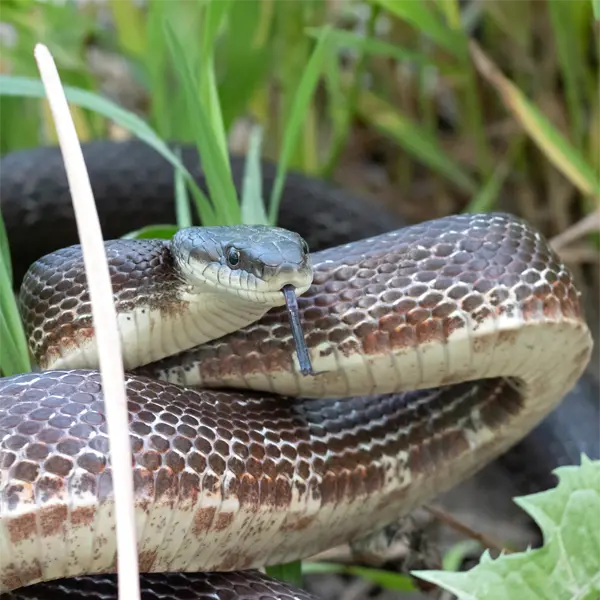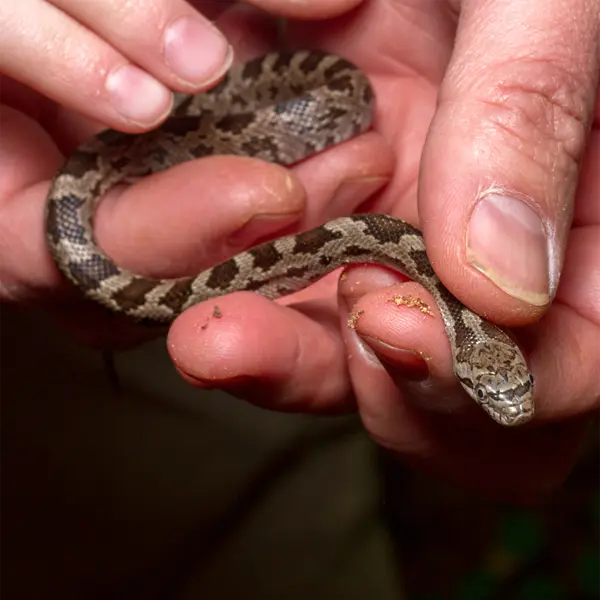Eastern Ratsnake
- Scientific Name
- Pantherophis alleghaniensis
- Also Known As
- Yellow Rat Snake, Everglades Ratsnake
- Range
- All of Florida, except Panhandle
- Diet
- Small Mammals, Birds, Amphibians
- Life Expectancy
- 15 Years
Quick Links
The Eastern Ratsnake in Central Florida
The eastern ratsnake (Pantherophis alleghaniensis) is a large nonvenomous colubrid snake native to central Florida. Often confused with other ratsnake species, the eastern ratsnake can be identified by its distinct color pattern and scalation.
This comprehensive guide provides detailed identification tips, biology facts, and prevention methods for the eastern ratsnake in central Florida. Read on to learn about eastern ratsnake habits, reproduction, diet, health risks, signs of activity, and professional removal options if you encounter this species on your property.
Appearance and Identification
Eastern ratsnakes can be distinguished from other snakes by their physical characteristics at both juvenile and adult stages
Eastern ratsnakes can be differentiated from other colubrids by their large size, smooth dorsal scales in at least 21 rows, divided anal plate, facial mask, and blotched juvenile coloration. Identifying skin sheds, trails, and retreats also helps detect eastern ratsnake activity and presence.
Maturation Rate
Young eastern ratsnakes grow quickly, reaching 2-3 feet (0.6-0.9 m) in their first year. They begin maturing around 2-3 years old when males can breed. Females may not breed until after their third year. Maximum size is attained in 4-5 years. The high reproductive rate helps compensate for juvenile mortality.
Habits and Behavior
Eastern ratsnakes are primarily diurnal but can be active at night as well. They are expert climbers and swim readily. When threatened, eastern ratsnakes may vibrate their tails rapidly providing a warning “rattle.” If further provoked, they may strike in defense and release a foul musk from their cloaca.
Eastern ratsnakes utilize a variety of habitats across central Florida including hardwood hammocks, pine flatwoods, scrub, swamps, barns, and other structures. They climb trees in search of bird eggs and nestlings. Hollow logs, burrows, and debris piles provide shelter. During cooler weather, eastern ratsnakes brumate underground or in stump holes.
Reproduction and Lifespan
Eastern ratsnakes breed in the spring after emerging from brumation. Combat between males may occur for access to females. Females lay clutches of 5-30 eggs in decaying wood, compost piles, or underground from late May through July. The eggs incubate for 60-80 days before hatching from August to October. Hatchlings grow rapidly feeding on insects, frogs, lizards, and small mammals.
Eastern ratsnakes may live up to 15 years in the wild. Their main predators include hawks, owls, coyotes, foxes, and other snakes like the eastern diamondback rattlesnake.
Ideal Habitat and Range
Central Florida’s humid subtropical climate offers suitable habitat for eastern ratsnakes year-round. Average temperatures range from the 60s°F (15-20°C) in winter to over 90°F (32°C) in summer. Annual rainfall surpasses 50 inches (1270 mm) with wetter summers.
Lush vegetation, abundant prey, and shelter exist across the region’s hardwood hammocks, pine forests, wetlands, farms, and developed areas. Rural buildings, storm debris, and dilapidated structures also provide retreats. The mild winters enable year-round activity and breeding. Due to these favorable conditions, eastern ratsnakes thrive across central Florida.
Diet and Feeding
Eastern ratsnakes are opportunistic predators of small vertebrates including:
- Small mammals – mice, voles, chipmunks, squirrels.
- Birds – robins, sparrows, quail eggs and nestlings.
- Amphibians – frogs, toads, salamanders.
- Reptiles – lizards, smaller snakes.
They subdue prey by constriction, killing by suffocation. Eastern ratsnakes use their forked tongue to detect chemical cues and find prey. They consume animals whole and can go weeks between large meals. Hunting occurs day or night on the ground and in trees.

Photo 80645966 © Holden, CC BY-NC

Common Health Risks
Eastern ratsnakes pose minimal health risks to humans. They help control rodent and insect pests that can transmit diseases through their predatory habits. However, a few precautions are advised:
- Bites – Eastern ratsnake bites are not venomous but have a high count of bacteria that can cause infection if not properly treated. Bites most often occur while handling snakes.
- Fleas, mites – Eastern ratsnakes may harbor external parasites that can bite or transmit pathogens to humans. Avoid direct contact and use gloves when handling snakes.
- Dander, feces – Allergens and germs associated with snakes, their cages, and feces may trigger allergic reactions or illness in sensitive persons. Use masks and disinfect cages.
Overall, eastern ratsnakes provide more benefits than risks by controlling pest populations. Basic precautions allow coexistence with low probability of health issues developing.
Preventing Eastern Ratsnakes
The main approach is reducing habitat appeal on your property. Trim vegetation back from foundations. Eliminate wood/debris piles and compost heaps where snakes may nest or hunt. Seal any openings wider than 1/4 inch to exclude snakes from entering sheds and garages where rodents may be present. Traps can remove individual snakes found inside homes or other areas snakes are not desired.
Eastern Ratsnakes in Central Florida – Conclusion
The eastern ratsnake is a common and beneficial predator species in central Florida. They help control rodents and other vertebrate pests around homes and agricultural areas. Basic exclusion and removal of individual snakes causing concerns are the best control methods.
Their importance for natural pest control means widespread elimination is neither possible nor desirable. With proper identification and sensible management focused on exclusion, eastern ratsnakes and humans can coexist with mutual benefits.







